The issue
Turning an aircraft around between flights poses many challenges when it comes to aircraft engineering inspection and maintenance. Most tasks involve working at height, in all weather conditions, and at any time of day or night. There are also times when tasks have to be performed under time constraints, as well as having to work around other service providers, including caterers, baggage handlers, etc. The aircraft itself presents many problems due to its shape and the areas that engineering staff need to access.
Traditionally the industry has used one particular design of steps for the past 20 - 25 years for all tasks; they are very versatile and allow access in, under and around the aircraft engine and to the cargo hold. However, from a safety point the design is very poor. The employee can be working nearly 2.5 meters off the ground with little or no protection from falling and when accessing the cargo hold a large unprotected gap is left. Our own accident statistics showed that over a four-year period the following working at height lost time accidents (10 involved access steps) occurred and resulted in a total of 478 lost working days.
| Broken Ribs | Fracture | Sprains & Bruising | Near death accident | Total |
|---|---|---|---|---|
| 2 | 1 – arm 1 – wrist 1 – toe |
5 | 1 | 11 |
In 2004 we decided to look at the step design and try and find a better solution. Added impetus to find a compliant solution came about with the introduction of the Work at Height Regulation 2005 and BS EN 12312-8:2005 ‘Aircraft maintenance stairs and platforms’. Any steps designed would have to be towable, easily manoeuvrable by one person and be able to withstand the harsh working environment at the airport.
Old traditional steps
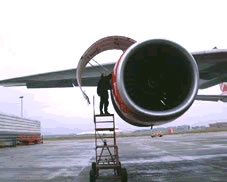
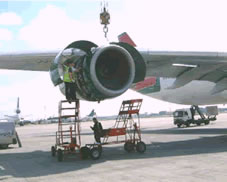
What we did
Initially, we tried to design one set of steps to do all tasks. We gave our preferred supplier a design brief and they designed and built a set of steps. The resulting steps proved to be much larger than expected, they where fine for accessing the cargo hold of the 3 aircraft types we operated but too big to work under and around the aircraft engines. We also made the mistake of trying to design the steps rather than tell the supplier what the problem was and let them come up with the design. It was around this time that we had a serious accident when an engineer fell from the cargo hold sustaining serious back and head injuries. This made us re-look at the steps that had been designed; we modified the top of the steps with swing out adjustable gates.
Steps with swing-out adjustable gates
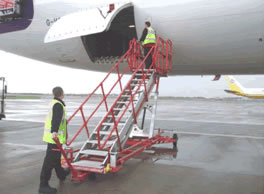

The result was a lightweight, easy manoeuvrable, height adjustable set of steps capable of giving total protection to persons working in the cargo hold. The adjustable swing out gate and height meant that they could be fitted to all our aircraft types.
The steps have now been in use for 2 years. They are very well liked by the engineers and are finding other uses such as working under the main wings and accessing the engine spar area.
These steps resolved the issue of the cargo hold access however we still had to solve the problem of working under and around the engine. This time we showed the supplier the problem and they came up with a design and manufactured a set of trial steps. We put the steps on trail and this included obtaining written feedback from the engineers.
Following the feedback some modifications were carried out and the steps put back on trail. These steps provided flexible and safe working platform at 3.2m allowing full access for two engineers under the engine cowls and around the out board engines on the A340-600.
Steps for working around and under engine cowls
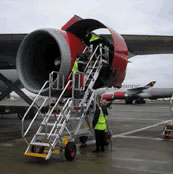
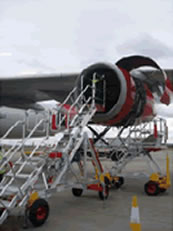
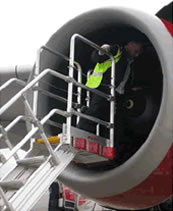
The design had addressed all the initial requirements. However it was clear from the engineers feed back there was the need not only for one all encompassing multi purpose set of steps but also a simple compliant set of steps with the working platform heights (1.8m & 0.6m) as per the existing old set of steps. This was required for simple routine jobs like oil top up without opening the cowlings and fan blade inspection.
The engineers preferred the old basic design but brought up to the correct legislative standards. So we went back to the drawing board and the supplier came up with a simple set of steps based on the same foot print and height of the old steps. They were slightly modified for length to help comply with the new standard with added fixed hand rail on the stairs and guard rails to the top platform. The guard rails could easily be swung up or down by one simple action depending on whether or not they were needed. When working under the engine the guard rails get in the way and are not needed as the user is protected from falling by the engine itself. The third unprotected edge has a removable guard rail which we are looking to change to a swing out gate attached to the side guard rails. A set of steps was built and put on trail.
Steps with swing-out adjustable gates and adjustable guards
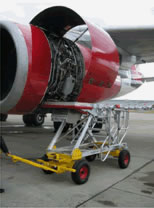
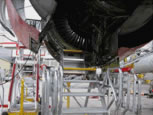
We have had positive feed back from the engineers and our current thinking is to replace the old steps with the basic steps for routine work on aircraft turnrounds together with the variable (2.2 – 3.2m) height adjustable steps for more detailed work.
The improvements and benefits
By working with our supplier and our engineers we have managed to demonstrate that problems can be solved if you have the will to do it. We now have a set of steps that are suitable for our business and are significantly safer to use.
"Safety and security is a key driver in everything we do at Virgin Atlantic, not only operating our aircraft safely but also ensuring we have a safe working environment for all our highly skilled staff, where they can work most effectively. People and safety sits high on our agenda and investment in these areas is taken extremely seriously and is key to our on-going success."
Steve Griffiths, Director of Engineering